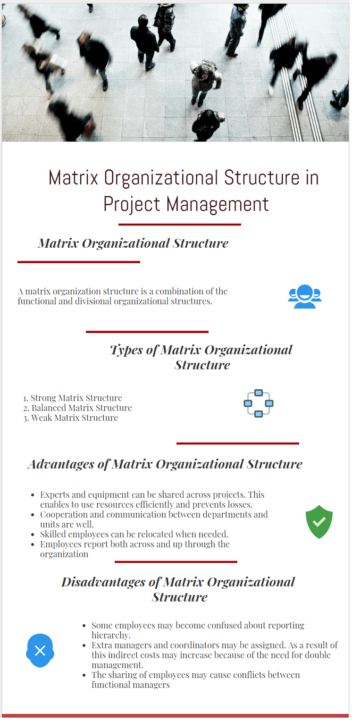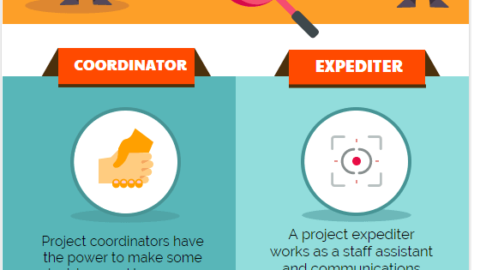In order to conduct organizational activities and manage projects in an orderly manner, organizations are established in various structures. Likewise organizations, projects involve many tasks from human resources management to budgeting and scheduling activities. Therefore a weak or rigid organizational structure cannot be adequate to bring success all the time. A matrix organizational structure is a company structure in which the reporting relationships are established as a matrix. An employee may have vertical and horizontal reporting lines. Also, an employee may be part of multiple departments and may have multiple managers. This article discusses matrix organizational structure advantages and disadvantages.
Table of Contents
What is Matrix Organizational Structure?
Every organization needs a well established organizational structure to reach the organizational goals. Typically, an organizational structure provides a framework for reporting relationship between employees. It also offers a way for coordinating organizational activities and routines.
A matrix organization structure is a combination of the functional and divisional organizational structures. Also, the PMBOK Guide defines the Matrix organizational structure as a combination of projectized and the functional organizational structures.
Functional organizational structures divide the company into departments such as marketing department, engineering department, sales department, etc. In Projectized Organizational Structure, the whole company is organized by projects rather than functional teams or departments. Divisional organization structures focus on the products, customers, geographical location, etc.
Large and multi-project organizations prefer matrix organizational structures where they can relocate employees whenever and wherever their services are needed. Because matrix organizational structures have the flexibility of relocating employees when needed. Also in a matrix organization structure employees may report to multiple managers.
For instance, let’s say that you are an electrical engineer in the engineering department of the head office and your company has a new project in a different region. In this case, you may be assigned to the project for the mobilization phase and you have to report to three managers. After completion of mobilization tasks, you will turn back to your head office and go on working in the engineering department.
Types of Matrix Organizational Structure
There are three types of matrix organizational structure. This classification depends on the authority and power of the project manager.
1. Strong Matrix Structure
2. Balanced Matrix Structure
3. Weak Matrix Structure
Strong Matrix
In a strong matrix organization structure, the project manager has extensive authority and power and the functional managers have limited roles. The project manager has full authority on the project budget. The strong matrix organization structure has the characteristics of the projectized structure.
Balanced Matrix
In balanced matrix organization structure, power and authority are shared between the project manager and the functional managers. The project manager and functional managers control the project’s budget together.
Weak Matrix
In a weak matrix organization structure, the project manager has a limited role but the functional managers have authority and power. The project manager works like an expediter or a coordinator. Therefore the functional managers have authority on the project budget. The weak matrix organization structure has the characteristics of the functional organizational structure.
What are the Advantages and Disadvantages of Matrix Organizational Structure?
Advantages of Matrix Organizational Structure
Below are some of the advantages of this organizational structure.
- Experts and equipment can be shared across projects. This enables to use resources efficiently and prevents losses.
- Cooperation and communication between departments and units are well.
- Skilled employees can be relocated when needed.
- Employees report both across and up through the organization.
- Enables team members to take some decisions. This encourages a democratic leadership styles and increases motivation.
Disadvantages of Matrix Organizational Structure
Below are some of the disadvantages of the matrix organization structure.
- Some employees may become confused about reporting hierarchy.
- Extra managers and coordinators may be assigned. As a result of this indirect costs may increase because of the need for double management.
- The sharing of employees may cause conflicts between functional managers
- Shared authority and power may cause conflicts between functional managers and the project manager.
- Matrix Structure brings more complexity
- It is expensive to maintain the structure
Matrix Organizational Structure vs Functional
The matrix organization structure was born in the aerospace industry in the U.S to handle sophisticated projects. Then it became popular to manage multiple large and complex projects of an organization. For this purpose, organizations establish strong, balanced or weak matrix structures depending on the requirements.
Within an organization, highly hierarchical structure, fragmented functions, and skills can cause problems that prevent to reach the goals. This type of organizational structure provides solutions for conflicts that originate from unclear functions and ill-defined responsibilities of managers.
As mentioned above, a matrix organizational structure is a combination of the functional and divisional structures. This combination brings flexibility and efficiency while performing tasks. Unlike the traditional top-down hierarchy, employees and managers make across departments can make more decisions. However, organizations that produce standard products and operate in a static environment may adopt the functional organizational structure rather than the matrix structures.
Summary
Organizational structures help organizations to coordinate their business in an effective way. Well-defined roles, responsibilities and reporting hierarchy is key to avoid conflicts. Before to implement an organizational structure type to a company, the benefits, and limitations of the structure should be analyzed. Because for a small company implementing a functional organization structure may be better than implementing a matrix organization structure. Likewise, if a company is big and the projects are large and complex, a matrix organization structure will be more effective. In this article, we discussed matrix organizational structure pros and cons. Hope that it will be useful for the pmp aspirants.
External References

Bianca Scarlot is a technology and business leader with multi-industry experience. Throughout her career, she has provided the expertise and direction for leading-edge initiatives that included agile transformations, process reengineering solutions, and IoT service delivery innovations. She is director of AgileNova Training Academy.










